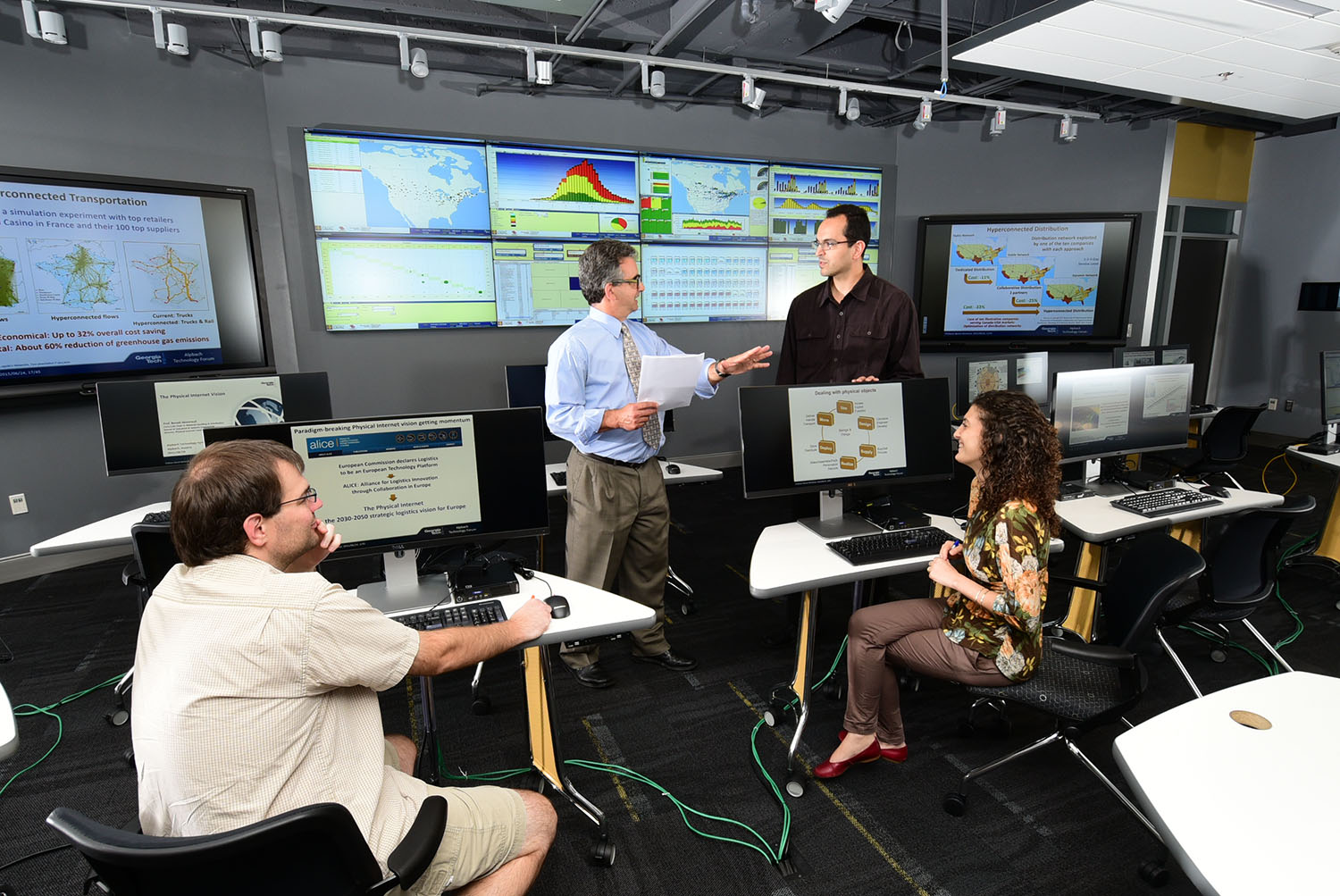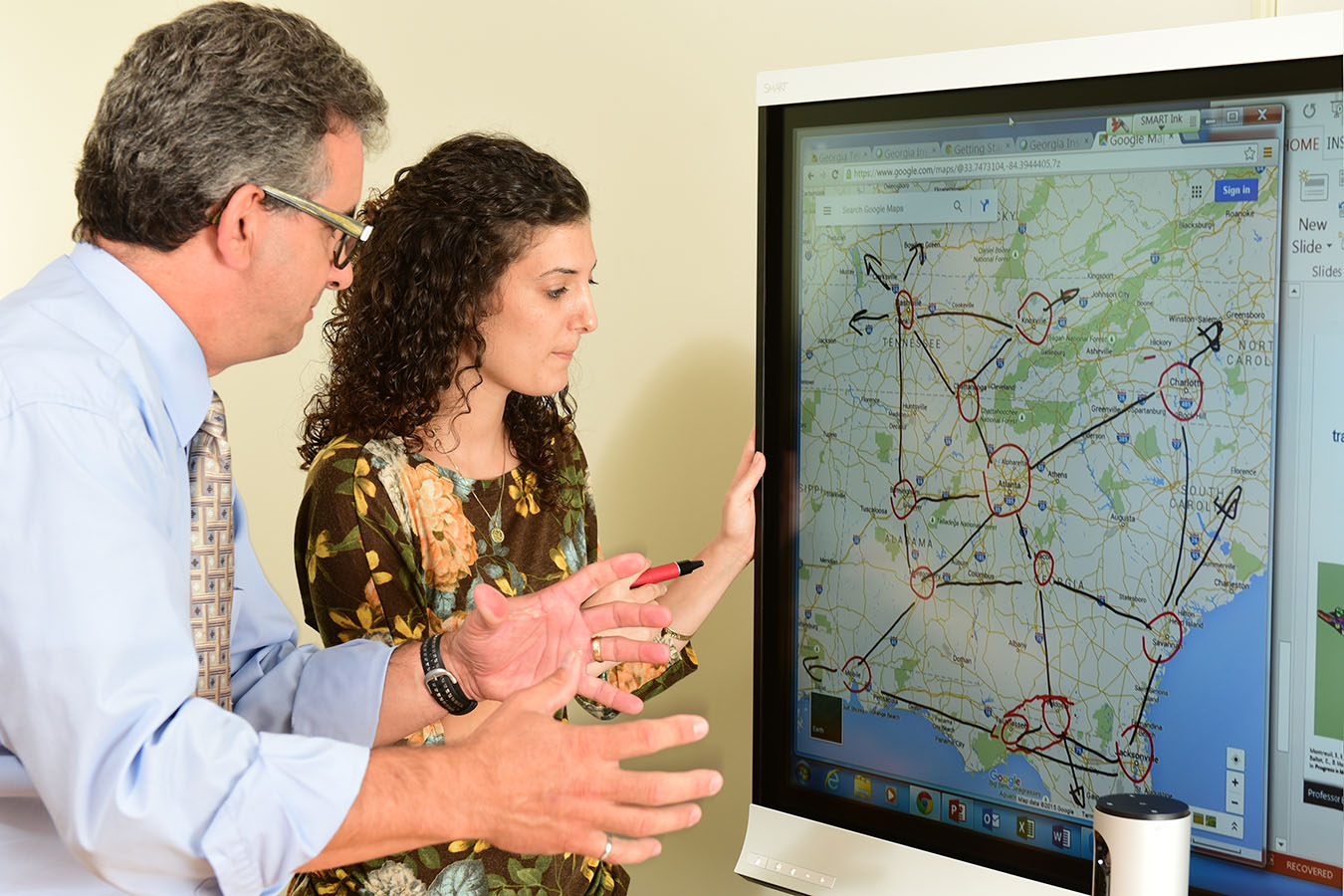When it comes to supply chains and logistics, not only is Benoit Montreuil thinking outside the box, he's rethinking the box itself.
The Coca-Cola material Handling and Distribution Chair in the Stewart School for Industrial & Systems Engineering (ISyE) at Georgia Tech, Montreuil is catalyzing a forward-looking new approach to the business of transporting, handling, and storing tangible goods. He calls this system the "Physical Internet."
"We are trying to transform the logistics and supply chain system to a new era of hyperconnectivity that is more sustainable and much more efficient than what we have now,” said Montreuil, who graduated from Université du Québec à Trois-Rivières in 1978 and received a master’s and a Ph.D. in industrial engineering from Tech in 1980 and 1982 respectively.
“We’re using the Internet as a metaphor,” he explained, “but instead of moving data, we’re talking about moving physical goods. The Physical Internet takes some of the basic characteristics of the information Internet — open access, standardization, interconnectedness, digitization, speed — and applies them to the operation of supply chains and logistics.”
At Georgia Tech, this ambitious effort is based at the ISyE’s new Physical Internet Center founded by Montreuil, who serves as its director.
The center’s mission is threefold. One is to provide worldwide scientific leadership in the development and implementation of the Physical Internet, and to position the center as the primary resource for education and innovation. The second is to pursue technological breakthroughs through the center’s research lab.
“In order for the Physical Internet to happen, we’re going to need technological innovation,” he said. “We want to steer that process and work with industry, technologists, and scientists to develop breakthrough technologies.”
Among the areas of research interest are supply chain analytics, digital platforms, optimization, stochastics and simulation, and system informatics and control.
The third aspect of the Physical Internet Center’s mission is to engage its corporate partners as “living laboratories to enable change in the field” for testing and applying new technological advances in real-world, practical situations.
To support its mission, the center plans to secure grants, pursue partnerships in academia and business, and participate in consortiums, Montreuil noted. It will also offer technical services in a range of areas related to the phase-in of the Physical Internet, which is expected to span decades, given the scope and complexity of the task.
“It’s not something you can do overnight,” he emphasized. “The Physical Internet is a progressively deployable, long-term solution to achieving a more sustainable global supply chain.”
As Montreuil describes it, the Physical Internet is an open market where the transportation, storage, realization, supply and usage of goods conform to common physical and operational standards worldwide. In other words, supply chains and logistics operate, in effect, as a single integrated, coordinated system worldwide. The system is highly computerized, allowing for continuous real-time tracking and monitoring, and features asset sharing across industries over interconnected networks and transportation modes.
At present, “everybody has their own supply chain,” he noted. “They have their own logistics, and they have their own manufacturing facilities and distribution centers, or they deal with their own service providers.” Even companies that conduct international business typically pool only their own assets to meet their needs, he added. “In the Physical Internet, we’re rather talking open asset sharing on a massive scale.”
As an example of a potential Physical Internet innovation, Montreuil points to plans for new kinds of modular containers designed for efficient transportation, handling, and storage. Built to standard dimensions, they lock together somewhat like Lego blocks. They’d be durable, light, reusable, and fabricated from recyclable materials. Different structural grades would be available, notably transportation, handling, and packaging containers. These “smart” containers would be communication-enabled, giving each one a unique signature to facilitate tracking and provide relevant data about the container’s contents, and ultimately take autonomous action as needed along their journey through the Physical Internet.
Each link in the producer-to-customer chain — from conveyor belts to trucks to warehouse layouts — would be adapted or built to accommodate the containers’ dimensions with little or no wasted space.
The benefits inherent in an integrated, standardized supply chain and logistics network include time- and energy-saving efficiencies that yield lower costs while boosting productivity, according to Montreuil.
He cites a study by the National Science Foundation indicating that if only one-fourth of U.S. manufacturers adopted the Physical Internet, and even if the transportation segment of that fraction was limited to trucks, the industry could realize $100 billion in annual savings while achieving a 32 percent reduction in greenhouse gas emissions.
The Physical Internet Center draws upon the research capabilities of resources from multiple disciplines, including ISyE centers such as the Supply Chain & Logistics Institute, the Center for Health & Humanitarian Systems, the Center for Analytics Research and Engineering, the Center for Predictive Analytics and Real-time Optimization, and centers across campus, such as the Center for the Development of Applications of the Internet-of-Things.
“We’re going to work with the top minds on the academic side,” he said. “At the same time, we want to be closely aligned with industry. We’re going to be very collaborative in Atlanta, and across the U.S. and the world. Many of the large companies based in Atlanta want to move forward. They understand that the status quo is not going to work for the medium term, and they want to put themselves ahead of the game. We’ve got several companies lined up through next year to work together with us on projects.”
A number of Physical Internet investigation and implementation efforts are taking place around the world, Montreuil observed, several with his assistance. Substantial investments already have been made in Europe, where the Physical Internet is the “official grand vision for all logistics and supply chains in the 2030-to-2050 time frame.” China has already established a Physical Internet research laboratory.
In addition, the continuing globalization of the economy has fostered a number of free-trade agreements that make a case for deployment of the Physical Internet because it would help “make these agreements feasible and work at the ground level.”
In North America, “achieving critical mass for the Physical Internet requires exploiting existing infrastructures and means, then gaining momentum through large-scale adoption and innovation,” said Montreuil. “We want to make sure we’re following a road map that makes sense in enabling this vast space of investigation, innovation, testing, and implementation.
"At the Physical Internet Center, we’re the nexus of this activity.”

